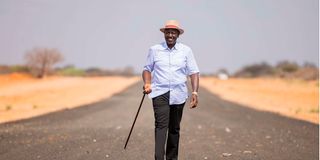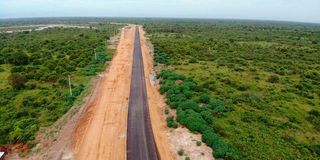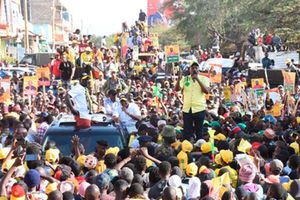
President William Ruto inspects section 1 of the 257km Lamu-Ijara-Garissa road on February 7, 2025.
President William Ruto’s summary of the completion of construction of the 750-kilometre Isiolo-Mandera road by 2027 could have been just that — a promise to finish an idea mooted and begun during President Mwai Kibaki’s time, but which remained unfinished during his successor Uhuru Kenyatta’s time.
But this was no ordinary road — or delivery of its completion promise by President Ruto.
The dropping of the names of the towns— Mandera, Rhamu, Gari, Elwak, Kobo, Tarbar, Kotulo, Wajir, Samatar, Modogashe and finally to Isiolo— has gained social media notoriety, complete with T-shirts, dance challenges, and thousands of memes.
Responding to the social media “jokers”, President Ruto said many Kenyans don’t know how passionate he is about development projects in the country.
“I fairly know many places and I would tell you the roads in Northern Kenya the way I would tell you about the roads in central, Western Kenya and many parts of the country,” Dr Ruto said in a video widely circulated on social media.
He went on: “This is because it’s my job…this is the job I applied for to think about the country and to know what to do where and make sure that no part of Kenya is left behind.”
Vision 2030 Blue Print
But while the President may have criticised them, the buzz around Rhamu, Gari, Elwak, Kobo, Tarbar, Kotulo and Samatar has cast a spotlight on the project hitherto unknown to many Kenyans.
Mooted by President Mwai Kibaki, the road project is part of the Vision 2030 Blue Print with a focus on the Lamu Port South Sudan Ethiopia Transport (Lapsset) Corridor.
It is managed by the Lapsset Corridor Development Authority.
An ambitious project, Lapsset was to see development of several projects including the 32-berth Lamu port, construction of roads, railways, an oil refinery and pipeline as well as laying of fibre optic cables along the corridor linking Kenya with Ethiopia and South Sudan.
In the plan, Diani in Kwale County, Lamu and Isiolo were designated as resort cities.
The project was supposed to create two million jobs and Sh250 billion revenue in trade value by 2030 annually. Cumulatively, the projects were estimated to cost over Sh2.4 Trillion.
“The Lapsset Corridor consists of two elements; the 500-metre-wide Infrastructure Corridor where the road, railway, pipelines, power transmission and other projects will be carried and the Economic Corridor of 50 km on either sides of the infrastructure corridor where industrial investments will be situated,” the Lapsset Authority says in a brief.
Some of the highways to be built in the corridor are Lamu to Isiolo, Isiolo to Nakodok and Juba (South Sudan), Lamu to Garsen (Kenya) and Isiolo-Moyale-Addis Ababa (Ethiopia) which is already complete.

The Ariel View of the Hindi-Junction to Kililana’s Lamu Port site access road under construction in 2020. The Lapsset Corridor Access Road has failed to make meaningful progress owing to frequent al-Shabaab attacks that have left scores of construction labourers on the project dead.
The road project transverses Isiolo, Meru, Wajir, Garissa and Mandera counties and is expected to open up the Northern region and enhance domestic and regional trade.
Launched by World Bank
In November 2021, the project was launched in Isiolo by the World Bank, which is the lead financier, with northern Kenya leaders and residents hailing completion of the road as their “saviour” from decades of marginalisation. This was during President Uhuru Kenyatta’s second term.
According to the Wold Bank, the project is part of a plan to open up the northern region with various projects lined up, which will cost over Sh130 billion.
Other financing partners include the African Development Bank and a Consortium of five Arab banks.
The goal
Once complete, the road will lead to improvement of security along the corridor and cut travel time from Isiolo to Mandera by half from 96 to 48 hours.
Besides the 750-kilometre road, there will be spurs of more than 50 kilometres into selected facilities and urban centres along the corridor.
A 740-kilometre fibre optic cable will also be laid from Isiolo to Mandera and another 200 kilometre spurs to major facilities along the corridor.
“There will be development of social infrastructure for the host community including pastoralist roadside markets, clean water, extending electrification to selected centres, provision of milk coolers, slaughterhouses, veterinary posts and livestock holding areas in selected locations,” says a brief by Kenya National Highways Authority.
“The objective of the project is enhancing connectivity among the HoA (Horn of Africa) countries and access to seaports; facilitation of domestic and regional trade and economic integration, and road safety. The Project will also enhance regional trade, improve transport of people, goods and strengthen institutions,” it adds.
Backlash
However, plans to dissolve the Lapsset Corridor Development Authority has drawn criticism from players in various sectors of the economy.
Mr Abdi Farah, a development practitioner based in Nairobi says rather than dissolving the authority, it should be strengthened as the private sector is involved in the development of the projects envisioned in the corridor.
“To position Kenya as a global competitor thorough Lapsset, the government must strengthen the project’s governance structure to effectively oversee investments across diverse areas,” Mr Abdi Farah, a development practitioner based in Nairobi said in an opinion article in the Nation.Africa







